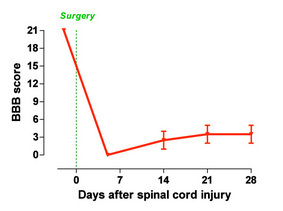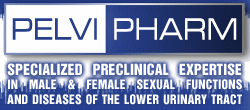Locomotor activity evaluation (Basso, Beattie and Bresnahan (BBB) score test )
Objectives
- Test the locomotor functions using an open field locomotor scale, described by Basso, Beattie and Bresnahan (BBB) from complete paralysis (score 0) to normal locomotion (score 21), to assess recovery after contusion injuries in rat spinal cord [Basso DM. et al., 1995; Basso DM. et al., 1996]
- This is an efficient, expanded, and unambiguous locomotor rating scale to standardize locomotor outcome measures across laboratories
- This widely used BBB Locomotor Rating Scale offers investigators a more discriminating measure of behavioural outcome to evaluate treatments after SCI [Mitsui T. et al., 2005; Pikov V. et al., 2001; Liebscher T. et al., 2005; Erschbamer M. et al., 2007]
- The evaluation of the functional motor recovery can be indicative of the regeneration of lesioned spinal cord.
Species
Rat
 |
| Figure 1: Locomotor recovery monitored with the BBB-open-field locomotor score after spinal cord injury (Pelvipharm, internal data). |
Summarized methodology
To assess the locomotor outcomes after spinal cord injury, rats are trained twice the week before the surgery to move in an open field which is a molded-plastic circular enclosure with a smooth, nonslip floor. Rats are allowed to move freely and are scored during 4 minutes by two observers for their ability to use their hindlimbs. Joint movements, paw placement, weight support, and fore/hindlimb coordination are judged according to the 21-point BBB locomotion scale. Postoperative open field testing can then occur at day different times after spinal cord confusion or transection.
Endpoints
- BBB locomotor score
Related Pelvipharm bibliography
Non disclosable information for confidentiality reasons

Links to applicable Targeted disorders / Pathophysiological models





















 Download this page in PDF
Download this page in PDF